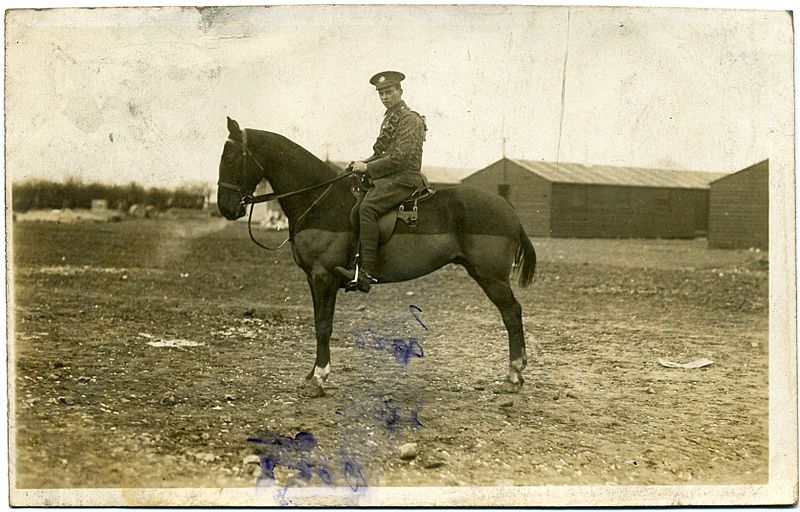Image: Fred C Palmer equestrian portrait WWI

Description: Postcard photo of Lance Corporal A. K. Croker of the Lancashire Hussars in 1915 during World War I. The postcard is postmarked Canterbury 3 February 1915. Croker has written a note on the back with the same date and Canterbury location, saying he had been stationed in Canterbury since October 1914. It is addressed to Miss Milly Taylor of Bolton, Lancashire. Croker is listed on the Manchester Employers Roll of Honour 1914-1916, in relation to Robert Spencer & Nephews company (source: Manchester & Lancs Family History Society). He was born in 1891 in Drypool, Hull, and at the age of 20 yrs in 1911 he was a boilermaker apprentice. He was the second eldest of 10 children of T. Croker, a boilermaker from Plymouth. (source: Census 1911, Sculcoates). His regiment was 1st Lancashire Hussars Yeomanry, and details of its WW1 action are here. The regiment was based in Kent from August 1914 to November 1918, then transferred to Salisbury Plain, Egypt and France. A document which may refer to Croker is a form kept in the Infantry Records, Preston, showing decorations granted under Order 20 in 1919, for the 18th Bn The Manchester Regiment. It shows Private A. Croker 10630, killed in action 1st July 1916. (Source Ancestry.co.uk) Note: the subject is not related to, or known to, the uploader of this photograph. He is a subject of general historical research on the grounds that those who served in, or died in battle in WW1, are of interest to the public. The photographer was Fred C. Palmer of Tower Studio, Herne Bay, Kent (as printed on the back of the card). He lived there 1903-1922, and is believed to have died 1936-1939. The soldiers based closest to Palmer's studio in 1914-1915 were The Buffs, (East Kent Regiment), which raised nine battalions in World War I. (Today the Buffs are amalgamated into the Princess of Wales's Royal Regiment.) Points of interest The ink is smudged perhaps due to rain or damp storage conditions, or perhaps due to tears as many men were lost in that war. The barracks in the background may be the Canterbury barracks formerly occupied by the Buffs. The horse has a hunting cut, intended to facilitate the removal of mud from the underbelly. Border The remaining border of this image is important for researchers of this photographer. Some photographers trimmed their images more than others, and Palmer has a reputation for producing smaller postcards than other early 20th century UK photographers. He took his own photos, developed them in-house onto postcard-backed photographic paper and trimmed them himself. It is worth adding that during hand-developing the border is actively masked with equipment which both crops the picture and causes the white frame or border to appear on the paper. This frame is part of the design and is one of the reasons why the quality of Palmer's work is so interesting, and why there is an article and category for him on English Wiki. Researchers need to see exactly where the edge of the postcard is. Thank you for taking the time to read this.
Title: Fred C Palmer equestrian portrait WWI
Credit: Scan of original postcard in my possession
Author: Frederick Christian Palmer
Permission: out of copyright
Usage Terms: Public domain
License: Public domain
Attribution Required?: No
Image usage
The following page links to this image:

